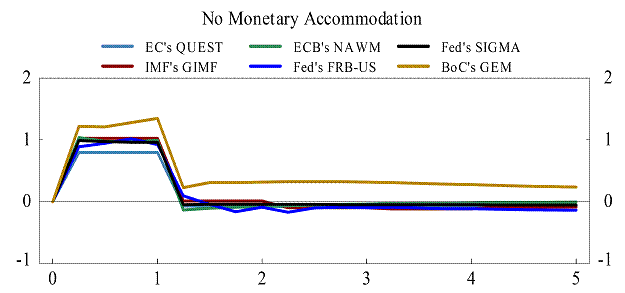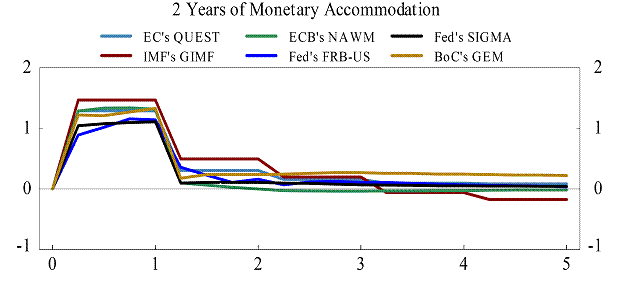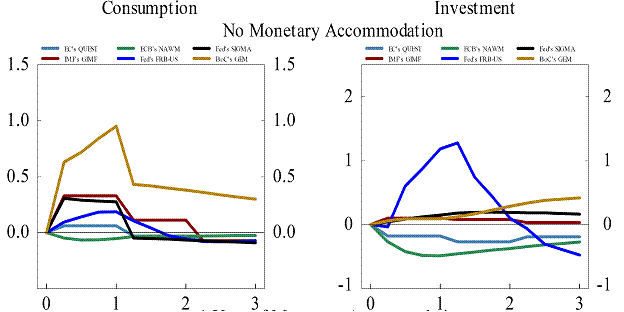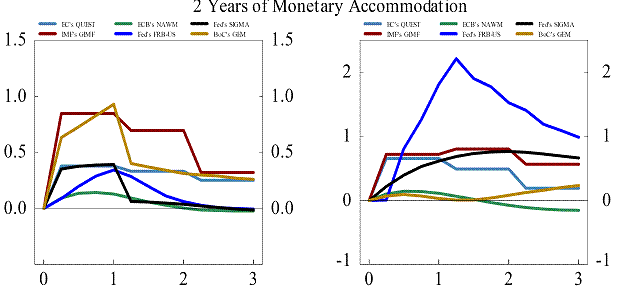Some people think that if one takes into account intertemporal dynamics, policy must necessarily be ineffective
In defense of Heritage, reader Jeff opines:
Zero crowding out? You can’t be serious? Perhaps it is you who should re-visit new keynesian models. A quick review of, say Smets-Wouters (2007), will reveal to you significant crowding out effects. But I’ll give you the benefit of the doubt and assume you did not just completely misunderstand mainstream new keynesian models and move on.
This quote is representative of a “read the abstract” or “read the conclusion” and skip the rest approach to fighting policy debates, so I thought it useful to step back and think through why certain papers have certain results, and whether they are directly relevant to the issues at hand.
First, some historical perspective. Early on in the Fresh Water/Salt Water debates, an oft heard argument was that New Classical models demonstrated that rational expectations invalidated the proposition of efficacious discretionary monetary policy. However, economists like Stanley Fischer and John Taylor demonstrated that price (or wage) rigidity in the presence of rational expectations still provided a role for policy. In other words, price flexibility drove the policy ineffectiveness proposition. Hence, the New Classical enterprise was partly a great marketing program employing, as in a card trick, a bit of clever misdirection. A similar attempt to confuse the debate of policy efficacy is going on now (not necessarily by academics, but more typically by those trying to influence policy), and there are many people eager to fall into the trap.
The issue here, as I have repeatedly stated, is not the inclusion of intertemporal aspects, or optimizing behavior; all sorts of DSGEs can produce different results. [1] (previously discussed in this post) This point is illustrated in this survey of DSGEs used by central banks. Even then, these models indicate a positive impact on GDP (rather than a zero multiplier as say the folks at Heritage would contend).

Figure 4, Panel A from Coenen, et al. (2010), United States: Effect of 1 Year of Fiscal Stimulus on Real GDP (Instrument: Government Consumption), no monetary accommodation.
The models are European Economic Commission (EC QUEST), European Central Bank New Area Wide Model (ECB NAWM), Federal Reserve Board’s Sigma (Fed Sigma), IMF’s Global Integrated Monetary and Fiscal model (IMF GIMF), Federal Reserve Board’s FRB/US and Bank of Canada’s Global Economy Model (BoC GEM).
One key assumption regards the monetary policy reaction function. Smets-Wouter (2007), a Bayesian estimated model, incorporates a Taylor rule (as do many papers, especially pre-2008). Cogan, Cwik, Taylor and Wieland (2009), often cited as a case of low fiscal multipliers, assume two years of monetary accommodation. Just to remind readers, this is what the Fed funds rate looks like.

Source: Deutsche Bank, Global Economic Perspectives, December 19, 2012.
The US policy rate has been flat at zero for nearly four years, and is projected to stay flat by Deutsche Bank for at least another year.
And this is what several DSGEs indicate the response of GDP looks like for a two year accommodation (not the four year accommodation we’ve actually experienced).

Figure 4, Panel C from Coenen, et al. (2010), United States: Effect of 1 Year of Fiscal Stimulus on Real GDP (Instrument: Government Consumption), 2 years of monetary accommodation.
I think it of interest that that cumulative output typically exceeds the one year government consumption impulse, so the multiplier exceeds unity. In all cases, the multiplier exceeds zero.
That’s crowding out of output. What about crowding out of investment? Certainly, the no-accommodation scenario seems to confirm the fiscal-policy skeptics’ view:

Figure 6, Panel A from Coenen, et al. (2010), United States: Effect of 1 Year of Fiscal Stimulus on Consumption and Investment (Instrument: Government Consumption), no monetary accommodation.
But what about the more relevant case where monetary policy has been accommodative?

Figure 6, Panel C (consumption on left, investment on right) from Coenen, et al. (2010), United States: Effect of 1 Year of Fiscal Stimulus on Consumption and Investment (Instrument: Government Consumption), 2 years of monetary accommodation.
In this scenario, one sees only one model predicting a decline in investment eventually (so the net effect looks close to zero) – that’s the ECB’s New Area Wide Model. The two Fed models, FRB/US and Sigma, indicate substantial crowding in.
For discussion of DSGE’s in policy analysis, see here and here.
By the way, see this post to see how John Taylor and Robert Barro used the counterfactual approach, so criticized by groups like Heritage[2]. And for those who want a nuanced survey of the New Keynesian/New Classical landscape, see Simon Wren-Lewis’s posts [3] [4].
First comment
Keynes is dead and the bond vigilantes are coming for us. Black helicopters overhead, buy your AR-15’s while you still can!!!!!!
Merry Christmas to you, too, Nick! Though I would say it is more like “Keynes is dead, long live Keynes!” because they seem to acknowledge that cuts to government spending (the military, particularly) might cost jobs rather than create them. But oh well…
And Merry Christmas to everyone! A random worker such as myself can learn new things every day here! If there’s no tomorrow, well, so be it. Otherwise see you around next year! I’m off to the airport!
Regards
Menzie,
You made an error in your title. It should read, “Confusion in the Keynesian Ranks.” Your argument seems to be old-Keynesian versus new-Keynesian. I always find it amusing when Keynesians prove one another wrong and then believe they have proved themselves right.
So, a state university employee, in the midst of a higher-education bubble that is about to pop, wants more government spending.
Um….yeah. Surprised, we are.
Darren: Thank you for your deeply insightful and thoughtful remarks. My views would be the same were I to work in a private university, or a research institute (which I had opportunity to do). Only people of a certain type would project their own craven self-interested nature onto others.
Menzie says: “But what about the more relevant case where monetary policy has been accommodative?”
Why don’t you include the response functions of inflation in the “accommodation scenario” against the actual path of inflation over the last four years and then try and argue that monetary policy has been accommodative?
Menzie, in the future may I suggest that before you simply cut and paste some charts you step back and think through why certain papers have certain results.
Hooray! Jubilation everywhere! It is hours past the start of the Mayan Day of Death and nothing. Time to dance and frolic, because we can continue these mindless arguments over failed/barely successful policies.
Jeff: These are deviations from baseline. Without the baseline forecasts, I can’t compare against actual. You dismissed the investment crowding in in plausible models; when confronted with models that exhibit crowding-in that are within the mainstream (even you don’t deny that), you segue to inflation forecasts. Geez.
Two paychecks from now, Nick, you’ll know whether the black helicopters have you or not!
But isn’t the interpretation of these charts that monetary policy was disastrously bad in the run up to the Great Recession? Didn’t the Fed allow a housing bubble to swell? Isn’t the whole thesis of the recession that it was an asset bubble, and that the need for de-leveraging is why growth is so slow? Aren’t asset bubbles the result of an excessively accommodative monetary policy?
Isn’t that the story?
And if the Fed was such a disaster in the 2004-2007 time frame, how do we know it’s not a disaster now?
So the issue is not merely whether monetary policy can be stimulative–are we actually debating that it can’t be?–but whether we know how and when to apply it, and more importantly, when to stop.
Steve Kopits: Asset bubbles (using the term bubble loosely) could arise from loosening of capital/asset ratios, partly due to deregulation, and the failure to rein in the subprime mortgage boom. I would give greater blame to the Bush Administration, and Alan Greenspan (on the regulation front).
Menzie,
I’m not sure what confusion you are referring to. Serious critics of the stimulus understand that introducing dynamic effects in Keynesian-style models does not render policy useless. The problem was that the stimulus was poorly designed.
I’ll repeat the points I’ve made a number of times in comments about why the stimulus failed to stimulate:
1) Projects weren’t really shovel ready, as the President belatedly admitted in this video:
http://www.youtube.com/watch?v=O55aRrvXtio
Most of the spending consisted of transfers with very little going to increase government purchases.
2) The tax cuts were temporary which the permanent income hypothesis suggests would be saved rather than spent.
Now look at Figure 7 in the Coenen et al paper, which shows that even with 2 years of monetary accommodation the multiplier is significantly less than 1 if the temporary fiscal expansion is made up of general transfers. Figure 13 shows that a temporary tax cut also produces a multiplier significantly less than 1.
That’s why the stimulus is failed policy.
Rick Stryker: Well, here’s an illustration of your confusion; to quote: “Heritage economists are indeed not using old-style Keyensian models. You can critique the model they are using if you want but it is a modern model.” But in the documentation you cited, you will see they use the IHS Global Insight model conjoined to their in-house black box. The IHS Global Insight is a estimated macroeconometric model in the Cowles Commission tradition, with short run Keynesian properties and long run Classical properties. Yet you didn’t understand that point. So, yes, confused.
By the way, I don’t need a DSGE to tell me that the multiplier for transfers (as well as taxes) is less than one in absolute value. I can get that out of an undergrad macro textbook. You would do well to read one sometime; let me suggest Olivier Blanchard’s (unless you think he is a hack, in which case I cannot help you).
Menzie: I’m not trying to shift the discussion to inflation forecasts, inflation is at the heart of the issue. To recap, I’m simply pointing out that the models that you are clinging so dearly too to show there is zero crowding out when monetary policy is accommodative. And I’m asking you to look at a graph of inflation over the last 4 years and try and argue that monetary policy has been accommodative. This is absolutely necessary for your argument to hold any water, even under your own assumptions. I’m sorry if you feel like this is an unnecessary diversion but unfortunately that’s how complete arguments are made.
Jeff: I see, I think. But the model comparison is based on a definition of “accommodative policy” = interest rate fixed, instead of Taylor rule or IFB. Returning to my point, I still don’t see how I can look at IRFs and compare against ex post realizations of inflation to judge whether monetary policy has been accommodative when I don’t know the baseline/counterfactual.
Menzie,
I’m not confused at all. These many-equation forecasting models started in the 1960s as straight Keynesian models but over the years have transformed themselves so that they are now a hodgepodge of features and ideas. I don’t consider them old style Keynesian models but if you want to define the IHS Global Insight model that way, that’s fine.
What I’m really interested in is that you seem to be acknowledging that the multipliers for the two big components of the stimulus were much less than one. If that’s the case, why do you keep claiming the stimulus worked? I’ve been consistent and clear on the point: the stimulus was poorly executed and ineffective. I think you secretly agree but just can’t bring yourself to say it. You should come clean and confess your true feelings. You’ll feel better.
Add to Keynes and we read Neo Keynesian and subs tract to evidences and we read the DGSE as per Adam Smith.
Pr Taylor is not so convinced that the prophets of economics, those who believe and do not know are not forging the Taylor rule. A 3% deviation that is the final tally, please refer to Economics one
Quantitative Easing on Steroids? An other great deviation on the way?
Is that a « little bit of cleaver misdirection » when we have been gratified by so many of them not only from the governments, political spheres and public functions. Meanwhile let us continue singing:
«You are my Shepherd, O Lord! Nothing can miss where you lead me »
Merry Christmas to all readers
Rick Stryker: The standard dividing line these days is between large scale macroeconometric models with adaptive expectations, versus microfounded DSGEs. I think almost all academic macroeconomists would use that categorization; IHS Global Insights (and Macroeconomic Advisers) would clearly fall in the former.
Yes, if we could have included more transfers to the states, and relied less upon tax cuts, it would have been a better stimulus package.[1] But I would not agree the stimulus was poorly executed and ineffective.
Rick Stryker If you will look at the appendix portion of the Romer-Bernstein paper you will see that they projected a multiplier less than one for the tax cut component of the stimulus. Recall that it was those on the Republican side of the argument that were demanding a larger tax cut component. Also, about 10% of the ARRA simply extended the AMT patch, which of course had zero additional stimulus because it did not represent a change. As to the supposed lack of shovel ready projects, I don’t see this as a serious criticism. First, the Great Recession has lasted long enough that almost any project could have been covered. And this isn’t just an after-the-fact observation. There were many who were predicting at the time that the risk of the recession being over before the projects were shovel ready was next to nil. Second, a well designed stimulus program will be designed so that the bulk of the spending is in the second year of the recovery, not the first year. Krugman explained why. So things didn’t have to be immediately shovel ready. Lastly, the economic impact of the stimulus doesn’t begin when the shovel hits the dirt; it begins when the project is obligated. It’s at the point of obligation that firms begin arranging for loans, start hiring, contracting for materials deliveries, renting capital equipment, etc. The point where the shovel hits the dirt is the disbursement piece and most of the economic effects on the disbursement side are second order.
I’m confused about your statement: “The tax cuts were temporary which the permanent income hypothesis suggests would be saved rather than spent.”
Okay, we all get the Friedman PIH thing. But weren’t Republicans arguing that the problem was too much consumption and that we needed more saving? That’s the way I remember things. Look, there was a coherent argument for tax cuts in the ARRA, but I didn’t hear conservatives make that argument. The fact that making the tax cuts temporary meant more of the tax cut would be saved rather than spent also meant that the tax cuts provided debt constrained consumers with an opportunity to repair balance sheets. Yes, making the tax cuts temporary would mean much of the tax cut would be saved (or used to pay off debt). But that is an argument for increasing government spending as well. If debt-burdened consumers want to save in order to repair balance sheets, then government must increase its spending in order to absorb the additional savings in the absence of private sector investment demand. If all you had were tax cuts that were saved, then that would be contractionary. But if that saving is offset with increased government expenditures, then there will be a positive stimulus. In other words, the tax cut piece of ARRA was really an argument for more complementary spending as well. If conservatives wanted to make a coherent argument for tax cuts, then they should have been arguing for more spending as well.
menzies you have a little scepticism but not enough
i”m for genuine data and scepticism. But you have a lot of euphemisms and buzzwords for mostly indefensible or unproven propostions widely held in the profession.
intertemporal dynamics? that translates as people will cut back their spending equal to current govt spending expecting they will eventually have to pay for 100% of that.
Well you can wander into this endlessly. But do they have idea or care how much they personally would have to pay.. basically its completely unproven bullsh.. For all you know people might work harder if you tax them and ramp up their bequest motive
I could go on here. But you get the point.
these models are mostly madeup with the conclusions already built in.
I ran a decent model. the Globalinsight one. Worlds biggest and most paid for. If government spends. And if there is slack in the economy and not much corresponding rate hiking. There is no real reason for the multiplier to be less than one, the name is multiplier for heavens sake.. there should be some follow on secondary and tertiary spending.
you will now understand why I laugh at this latest oops the multiplier is higher.. Duhhhh
Well, Menzie –
Now that’s an interesting thesis. De-reg + loosening cap/asset ratios. And the numbers?
Do we assume this also happened simultaneously in the UK, Iceland and Ireland? And thank God the Indonesians and Argentines held the tough line, even as the Italians and Greeks succumbed.
So how does that story go, exactly?
AWH: There is a difference between neo-Ricardian equivalence (which you cited) and intertemporal dynamics more generally; I’m not a big believer in the former. On the Global Insight model, I didn’t mean to say I like the DSGEs more than the GI model; merely that they are some key distinctions between the two types, and I think many academics draw a dividing line between the two.
Steven Kopits: Well, I could go through it all, but just buy this book.
Menzie,
You reassert that you think that stimulus was effective. But I wish you would explain why you think so when the models examined in the Coenen et al paper and indeed undergrad macro would lead you to think that the multipliers for the two major stimulus components are likely much less than one.
I agree with your division of the two model types. I have a strong preference for the DSGE models for policy analysis. The WEFA/DRI/IHS models are successful because they allow the user to make up the forecast through the ad factors. The model serves as a consistency mechanism once you do that.
2slugbaits,
The point I’m making on the spending side is that government purchases needed to go up substantially. They didn’t.
On the tax side, I would have preferred cuts in marginal tax rates. However, if the dems didn’t want to do that, if would have been much better to make the temporary tax cuts conditional on spending. Temporary tax credit for home improvements, buying a car, etc. would have been much better. Of the 237 billion in personal tax cuts, only a small part of it was designed this way.
@Steven Kopits: monetary policy in the runup to the Lesser Depression was nae great, but the bigger failure by far was in banking regulation: accounting control fraud was rampant, ratings agencies were on the take, fraudsters were making millions (in 2004 the FBI spoke of an epidemic of fraud), and it continued badly (has not ended yet).
Rick Stryker If you will recall, the Democrats did propose a larger mix of temporary tax credits. The Republicans opposed many of those tax credits on the grounds that they must be permanent rather than temporary. Of course, making investment tax credits permanent completely defeats the intent.
You seem to be arguing that the ARRA could have been better structured (which is true), therefore the stimulus was ineffective (which is not true). There were plenty of us who whined that the stimulus should have been much larger with a much larger spending component; but as flawed as it was, the stimilus was still better than nothing and it did have a positive effect on GDP.
ECB’s New Area Wide Model
So presumably this is one of the models Trichet referred to when he said I found the available models of limited help. In fact, I would go further: in the face of the crisis, we felt abandoned by conventional tools. If their own in-house models were so wrong, it would explain a thing or two about the cluster-f in Europe.
BTW I love that expresssion (“abandoned by”), as if ECB’s board was a blameless victim rather than persistent actor. Might I suggest that when the tools want to abandon you, don’t try and cling to them like a spurned lover?
Hey Menzie,
Even in Asia, Keynes is forgotten in times of prosperity..just read an open letter to the Philippine President about a brewing housing crisis:
AN OPEN LETTER TO PHILIPPINE PRESIDENT BENIGNO AQUINO III: NOW IS THE TIME TO PREPARE FOR A MASSIVE HOUSING CRISIS IN ASIA
(http://renohomeblog.com/2012/12/an-open-letter-to-philippine-p.php)
-Daytona
Ah, but as Noah Smith reminded us (http://noahpinionblog.blogspot.ca/2011/10/baxter-king-1993-why-government.html), if you take a plain vanilla RBC model and tweak it to include gov’t capital, then the multiplier can be huge,
So why don’t we hear the freshwater side demanding more gov’t investment now now now?
I disagree with your assumption that monetary policy has been accommodative for four years. Inflation has been on target, under the control of the Fed. The multiplier predicted under those circumstances is zero.